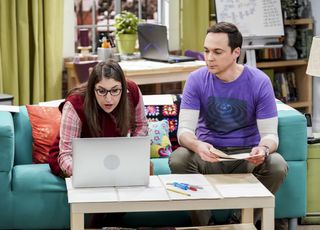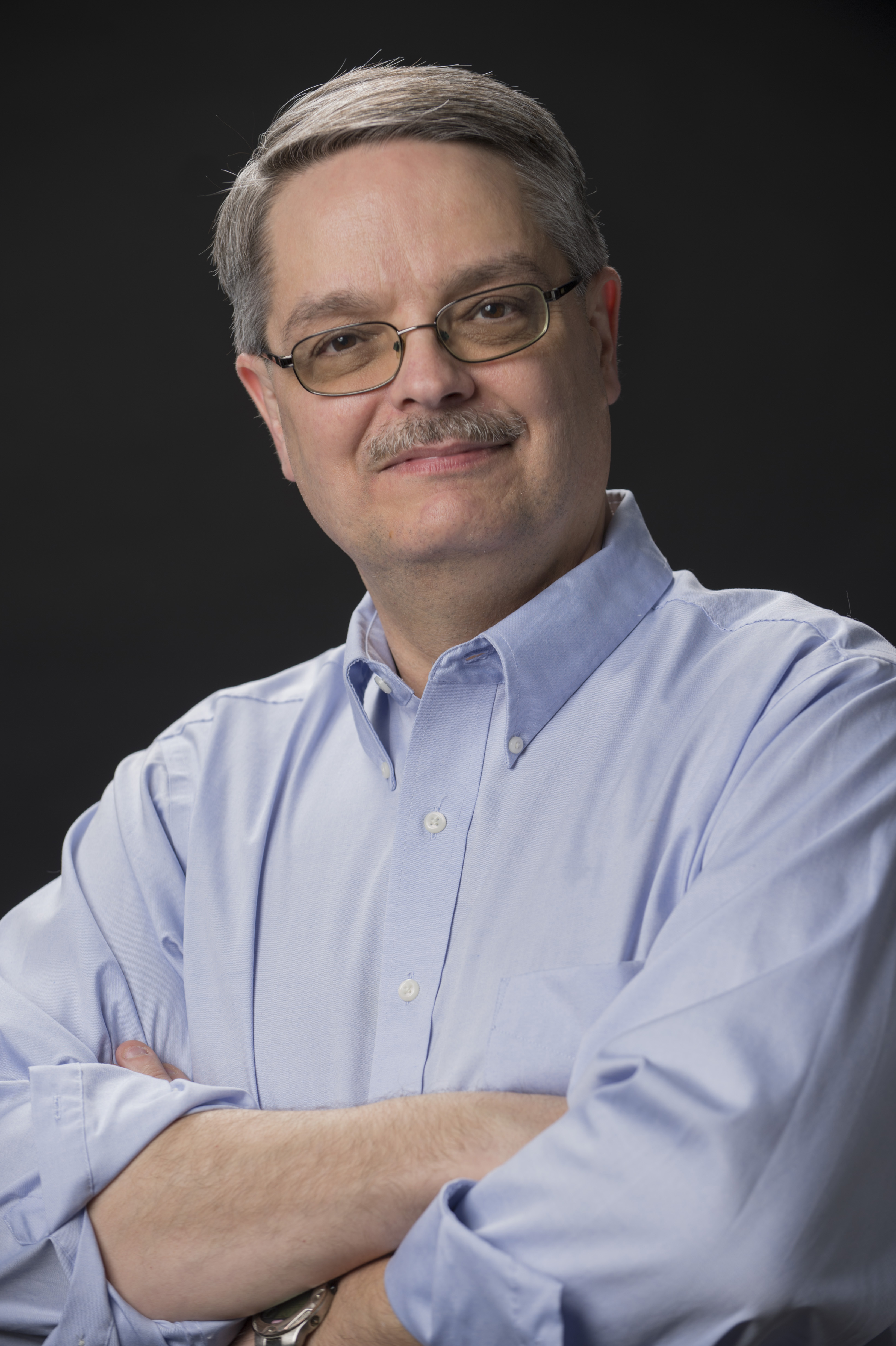What Made Amy and Sheldon Look at Their Paper Again
Did 'The Large Blindside Theory' Get the Science Right? A Lesson in Supersymmetry and Economy Class

They say that life imitates art, but the pointer goes both ways. Far more frequently, art imitates life. That's what happened in a contempo episode of the hit television set show "The Large Bang Theory." In the episode — "The Confirmation Polarization" — Sheldon and Amy receive an email from Fermilab. Two scientists had confirmed Amy and Sheldon's theory chosen Super Asymmetry. The researchers were studying a subatomic particle called kaons and the measurement and prediction (how it should carry in theory) disagreed. They called their measurement a failure until they realized that Amy and Sheldon's paper, published just a few months prior, explained the discrepancy. The 2 researchers were flown (in economy plus…more than on that later) to Caltech to meet Amy and Sheldon.
The Fermilab scientists are line-fishing for a Nobel Prize and, because no more than than three people can receive the prize, they are trying to cut Amy out of the picture. They tell Sheldon if he can get the President of Caltech to nominate the three of them for the Nobel, combined with the nomination from the head of Fermilab, they'd accept a strong case for receiving the award. Sheldon decides that if Amy isn't included on the nomination, that he doesn't desire to exist on it either and he tells that to the President, who explains how this volition upshot in a fight with Fermilab; he adds that he has their dorsum. The episode ends with the situation left unresolved.
So this episode was brought to my attention considering…well…Fermilab. Fermilab is a real place. I drive to it every morning in Batavia, Illinois. And it's a fantastic place to work if yous are fascinated by the subatomic world, which I am, and that means I become to drive to piece of work every day with a smile. But I thought people might be interested in learning about what was true and what wasn't in this episode. [Image: Inside the World's Top Physics Labs]
Let me kickoff by saying that I like "The Big Blindside Theory" a lot. And the writers effort non to stray too far abroad from real science in their episodes. In fact, David Saltzberg of UCLA is both a enquiry collaborator of mine and a scientific consultant for the show. He makes certain that the writers don't include any scientific topic that is too outlandish and disreputable.
Some people mumble about how the evidence represents the scientists in a cartoonish fashion, and there is truth in the criticism. Sheldon is but way over the top and about scientists don't actually act like that. (Although, truth exist told, I do know a single person who reminds me of Sheldon. I decline to place him on the grounds that everybody who has met him agrees with me.) Leonard is a lot more true to life, although even his grapheme is a petty more socially-clueless than reality. Scientists are by and large pretty normal people, with normal lives. They're just smart and very focused on their work. (Or, I suppose, I could be more like Leonard than I'd like to admit. I decline to ask anyone on grounds that I don't want to know the answer.)
So but how much does the episode ring truthful? To begin with, there is no real theory called Super Asymmetry. However, there is a theory chosen supersymmetry, which is a very popular extension of the standard model of particle physics — our best current theory of subatomic matter. While there has been no experimental confirmation of supersymmetry — which proposes that every particle identified in the standard model has a supersymmetric partner — it is well plenty regarded that at that place be over 10,000 scientific papers on the topic. And then, except for the poetic license on the name change, we'll give them that one. [The Big Bang Theory: How the Universe Began]
How most the experiment? Could ii guys at a laboratory like Fermilab ostend a theory like Super Asymmetry using kaons? Well, it'southward certainly possible that straight measurements of kaons could disagree with predictions and that a new theory is needed to explain that discrepancy. So, we'll requite them that i. But modern experimental groups accept way more two people on them. My ain enquiry group (which is diligently testing the idea of the real-earth supersymmetry) involves about three,000 scientists drawn from across the world. This experimental group, called the Compact Muon Collaboration, or CMS, uses data collected at the CERN laboratory in Europe. CERN is Fermilab'southward sister laboratory, and it hosts the Large Hadron Collider, which accelerates beams of protons to near the speed of lite, colliding them within a 5-story tall scientific apparatus, chosen the CMS detector.
The CMS collaboration is comprised of scientists from about 200 enquiry institutes. The Fermilab CMS group is made up of virtually 100 scientists and even more engineers, technicians and computer professionals. If CMS discovered supersymmetry, the credit wouldn't become to but two researchers from Fermilab.
And what nigh the Nobel Prize thing?
Information technology's certainly true receiving the Nobel Prize is the secret goal of any physicist. But at that place was a lot wrong with the description in the TV episode. For instance, Amy and Sheldon's paper had come out only a few months prior and at that place was just 1 measurement confirming the finding. That'due south absolutely zippo like how it would really happen. To begin with, there are hundreds of papers written predicting new concrete phenomena. Information technology takes a fair bit of time to compare the prediction to information; and it takes even more fourth dimension to dominion out all of the other predictions. In improver, if Super Asymmetry were real, it would make predictions that would take to be confirmed with other measurements. All of that work would take a lot of time. But let's chalk this upwards to "television time," like in the CSI idiot box shows when a Deoxyribonucleic acid test is done in ten minutes. So, I'll generously give them this one.
A large chunk of the plot focuses on who would get the Nobel Prize, if it were awarded. And this is a mixed pocketbook. It's true that the Nobel tin go to at most three people. Just the nomination process is dissimilar. Members of the Swedish Academy of Sciences can nominate, as can previous Nobel laureates and some distinguished professors who are asked for recommendations. So, it is possible that the Fermilab director is on that list. I don't know that he is, only he certainly has the international stature to be invited. Yet, it is unlikely that the President of Caltech is on the list. We'll call that a split.
When Sheldon declined to be nominated without Amy, there is historical precedent. For the Nobel Prize in Physics in 1903, Marie and Pierre Curie had done extensive piece of work in the newly discovered field of radioactivity. Given the era and the condition of women at the time, the initial nomination was only for Pierre, in spite of Marie being the intellectual leader of the couple. Pierre wrote the committee and declined to be nominated without Marie being co-nominated. He prevailed and the two shared the Nobel Prize with Henri Becquerel, some other legend of early on radiations studies. So that attribute of the episode rang very true.
The episode had a mix of fiction, truth and nearly truth, but it got me wondering what sorts of research at Fermilab might actually get the Nobel Prize. Looking in the past, there is the 1995 discovery of the top quark, although I think that one is unlikely. But, looking frontward, there are several experiments that might qualify 1 day. Currently at Fermilab, an experiment called 1000-2 (G minus 2) is studying how subatomic particles called muons wobble when put in a magnetic field. Muons are like chubby, unstable electrons, and before measured and predicted beliefs disagree in a tantalizing way. The grand-2 experiment volition establish whether the discrepancy means a discovery. If information technology is a discovery, it could well lead to a Nobel prize. Bringing the story back to "The Big Bang Theory" episode, a proposed explanation of the currently observed discrepancy is supersymmetry.
So there are some future experiments. DUNE volition study the behavior of neutrinos and antimatter neutrinos to look for differences. If they carry differently, it could be the explanation for why the universe is fabricated of matter and not equal parts of matter and antimatter. That would be a Nobel. And and so there's the mu2e (muon to electron decay) experiment, which looks for a specific type of muon decay. If observed, that'southward another Nobel.
And, of course, Fermilab scientists are looking for night matter and nighttime energy, mysterious substances that outnumber ordinary matter by a ratio of 20 to one and will determine the evolution and futurity of the universe. Those are fertile grounds for Nobel prizes too. Information technology could well exist that the episode's prediction of a Nobel prize for Fermilab will come up to laissez passer in spirit, if not in existent life. If you're interested in learning more than about the Fermilab future research program and these possible future Nobel prizes, I even made a video near it.
I suppose that I should tell you virtually the one thing in the "The Confirmation Polarization" that rang totally false. The Fermilab scientists flew economic system plus. Pfffftttt…total nonsense. For united states, information technology'south autobus all the fashion. If a traveling scientist wants a few precious inches of legroom, they have to pony up the difference. They shouldn't even tease like that. That was just mean.
Science on television is rarely exactly right and that'south OK. Most television is supposed to be entertaining. But information technology's squeamish when they can incorporate some real science into it. It can get kids interested in science. This is supposed to be the final season of "The Big Blindside Theory," and I'll be sad to see information technology go.
- The 11 Biggest Unanswered Questions About Night Matter
- Wacky Physics: The Coolest Little Particles in Nature
- Dreamy Images Reveal Dazzler in Physics
Don Lincoln is a physics researcher at Fermilab . He is the author of " The Large Hadron Collider: The Extraordinary Story of the Higgs Boson and Other Stuff That Will Blow Your Mind " (Johns Hopkins University Printing, 2014), and he produces a series of science didactics videos . Follow him on Facebook . The opinions expressed in this commentary are his.
Don Lincoln contributed this commodity to Live Science's Expert Voices: Op-Ed & Insights. Originally published on Live Science.
arterburnwhiressawd.blogspot.com
Source: https://www.livescience.com/64557-the-big-bang-theory-super-asymmetry.html

0 Response to "What Made Amy and Sheldon Look at Their Paper Again"
Post a Comment